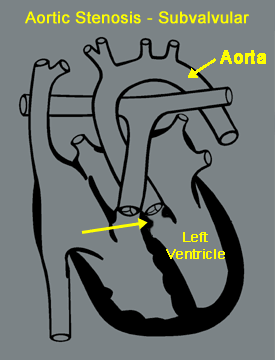 (rollover to compare with supravalvular)
(rollover to compare with supravalvular) |
|
What Are Its Effects?
The left ventricle, the main pumping chamber of the heart, pumps oxygen-rich blood through the aortic valve into the aorta, which carries it to the body tissues. If the opening to the aorta is obstructed, as in Aortic Stenosis, the left ventricle must work harder to move blood in this way.
In severe cases, this may cause the left ventricle walls to increase in thickness (hypertrophy), injury to the heart muscle because of reduced coronary blood flow and an irregular heartbeat (arrhythmia) and sudden death.
The other end of the spectrum is mild stenosis or commonly just a bicuspid aortic valve. As aortic stenosis can be progressive, even mild stenosis should be followed regularly until adulthood. Similarly, a bicuspid valve which may remain non-stenotic for decades, only to calcify and develop severe stenosis in the 6th to 7th decade of life. Symptoms of severe stenosis may include angina, labored breathing in response to exertion, or fainting (syncope). Some patients with a bicuspid aortic valve may also develop dilation (enlargement) of aorta.
In Subvalvular Aortic Stenosis, insufficiency (leaking) of the aortic valve may also occur. |